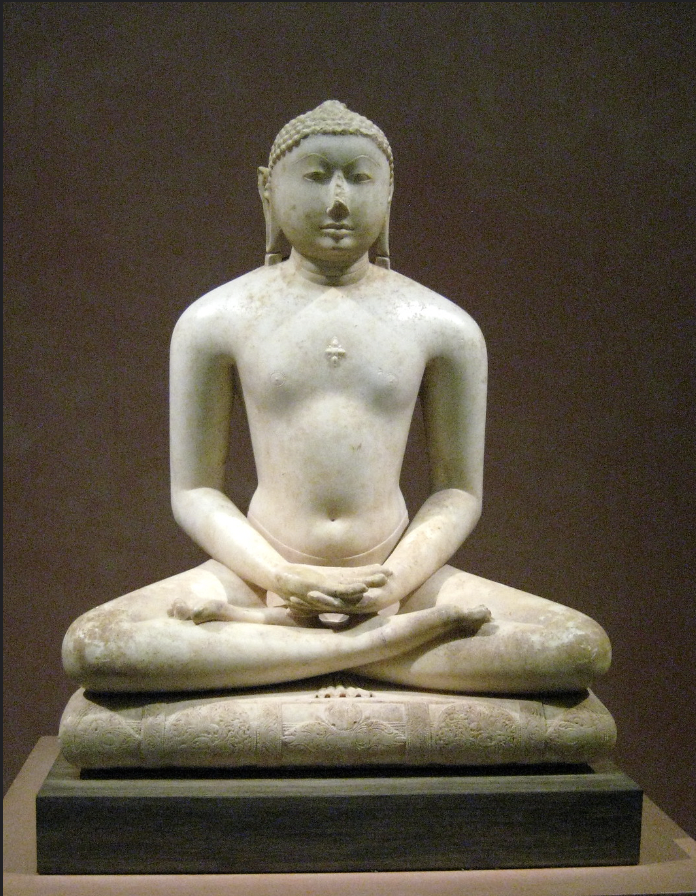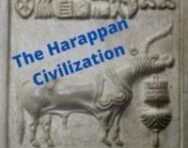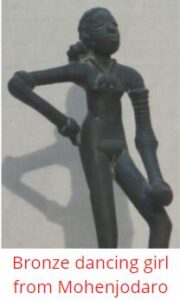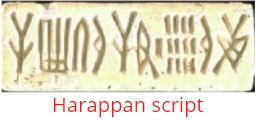
Jainism in India | Ancient History Short Notes
Jainism in India notes/study material for preparation of UPSC, BPSC, UPPSC and other State PSC Examinations.
Home » UPSC Study Materials » Prelims Express » Ancient History Short Notes » Indus Valley Civilization | Ancient History Short Notes

Indus Valley Civilization notes/study material for preparation of UPSC, BPSC, UPPSC and other State PSC Examinations.
Indus Valley Civilization was a Bronze Age Civilization that flourished between 2500-1750 BC in the north western parts of India and present-day Pakistan.
It is also called the ‘Harappan Civilization’ after the name of its first discovered site.
The term “Indus Valley Civilization” was first used by John Marshall.
There are four important stages or phases of evolution:
Important features of Harappan Civilization are as follows :
This is most unique feature of this civilization.
Whole settlement was divided into two sections:
Citadel :
This was constructed on mud brick platform. Therefore it was higher than rest of the town.
There are evidence of structures which were probably used for special public purposes.
Ex. – Warehouse, The granary, The Great Bath(The most important public place of Mohenjodaro – must have served as a ritual bathing site).
Lower Town :
Town planning was on the lines of the grid system with streets and lanes cutting across one another almost at right angles.
Houses were made of burnt bricks which were inhabited by the common people. There is large-scale use of burnt bricks and absence of any stone buildings.
Every house had its own bathroom paved with bricks. There was underground drainage system that connected all houses to the street drains. Drains were covered by stone slabs or bricks.
A great progress was made in all spheres of economic activity such as agriculture, industry and art and crafts and trade.
Wheat and barley were the main crops grown besides sesame, mustard and cotton. Evidence of rice cultivation has also been found from few sites.
Animals like sheep, goats and buffalo were domesticated. However, The use of horse is not firmly established. Fishing was also a regular occupation
Bronze and copper vessels are the outstanding examples of the Harappan metal craft. People of this civilization did not know about Iron. Copper was the most widely used metal. It was obtained from the Khetri copper mines of Rajasthan. Tin was possibly brought from Afghanistan.
Internal trade was extensive with other parts of India and had a guild system. Trade was based on barter system. The measurements were standardized with precise system of weights. Weights were usually made of a stone called chert and were usually cubical in shape.
Foreign trade was mainly conducted with Mesopotamia, Afghanistan, Iran and Oman. Many seals of Indus valley have been found in Mesopotamia which suggest close trade link between both the civilizations.
Gold, copper, tin and semi-precious stones were major imports. Main exports were several agricultural products and cotton goods, pottery, beads, terracotta figures and ivory products.
The Harappans had a great sense of arts and crafts which is proved by the evidences of stone/metal statues, toys, figurines, beads, seals etc.
The Harappan sculpture reveals the high degree of proficiency. A remarkable example of this is a bronze figure of dancing girl found from Mohenjodaro.
A remarkable example of this is a bronze figure of dancing girl found from Mohenjodaro.
They were experts in bead-making. Beads were extensively made and worn by men and women. Steatite, a very soft stone was extensively used for bead making. Use of ornaments made of gold, silver, copper, bronze and semi precious stones was also common.
The pottery of Indus valley civilization is another specimen of the fine arts of the Indus people. It is distributed throughout settlements. Pottery was generally plain however in some places red and black painted pottery is found.
Their notable artistic achievement was also in seal making.  There are engravings on both sides of the seals ( especially those of animals ).
There are engravings on both sides of the seals ( especially those of animals ).
Thousands of seals have been discovered by archaeologists from various Indus valley sites. Most famous among them is the Pashupati Seal from Mohenjo Daro.
The chief male deity was Pasupati (proto-Siva). He is represented in various seals as sitting in a yogic posture with three faces and two horns( See Image Above). He is surrounded by four animals (elephant, rhino, tiger and buffalo ). Two deer can be seen on his feet.
The chief female deity was the Mother Goddess who is represented in numerous terracotta figurines.
Linga worship and yoni worship( female sex organ ) was prevalent. Trees( Peepal tree ) and animals (Unicorn, Humped Bull etc.) were also worshipped by the Harappans. However, No temples or religious monuments have been found in the whole Civilization. This shows their architecture was completely utilitarian.
They believed in ghosts and used amulets as protection against them.
The Harappan script is still not fully deciphered. This is one of the reasons that we don’t know much about this civilisation.
The script was mostly written from right to left.  In few seals the boustrophedon method ( written from right to left in first line and from left to right in second line ) was also adopted. Script was pictographic and was engraved on various seals.
In few seals the boustrophedon method ( written from right to left in first line and from left to right in second line ) was also adopted. Script was pictographic and was engraved on various seals.
The people at Indus Valley Civilization had a very organised way of living.
The dress of both men and women was divided into two pieces, one upper garment and the other lower garment. A figure of a bearded man which has been found in Mohenjo-Daro indicate that they used sewn clothing.
Use of Beads, ornaments and cosmetics was common. Various household articles made of pottery, stone, shells, ivory and metal have been found.

The large number of terracotta figurines and Children’s toys such as cart, bull, elephant, monkeys, chariots have been found. Favorite pastimes for elders were hunting and bull fighting.
Various burial practices have been noticed at different sites. For example, evidence of complete burial and post-cremation burial were have been found at Mohenjodaro. At Lothal and Harappa, evidence of use of coffins has been found. Practice of pot burials is also found at Lothal
The extraordinary uniformity of Harappan artefacts such as seals, weights and bricks across the various sites indicate that the civilization was very well organised and administered. Despite this, there is no evidence of any ruler or any governing system for the Harappan civilisation.
Some archaeologists believe that Harappan society had no rulers, and that everybody enjoyed equal status. While some feel there was no single ruler but several.
Some other suggest that Harappa was possibly ruled by a class of merchants.
Although some weapons like axes, spears, daggers,and arrow-heads have been excavated from various sites, there is no evidence of warfare
Harappa is the first discovered site of this civilization.
Excavators – Daya Ram Sahni
Year – 1921
Location – Montgomery district of Punjab (Now in Pak) on the left bank of Ravi
Mohenjo-Daro (mound of dead) is the largest urban centre of the civilization.
Excavators – R.D.Banarjee
Year – 1922
Location – Larkana district in Sind on the right bank of Indus(Now in Pak).

City without Citadel.
Excavators – N. Gopal Majumdar, Mackey
Year – 1931
Location – Situated in Sindh on the bank of river Indus.
Kalibangan means ‘Black Bangles’.
Excavators – A. Ghosh
Year – 1953
Location – Situated in Hanumangarh district of Rajasthan on the Bank of River Ghaggar.
A relatively new discovery, excavated in 1990s.
Excavators – R.S. Bisht
Year – Around 1990
Location – Situated in Gujarat.
It was a coastal town with a dockyard.
Excavators – S.R. Rao
Year – 1953
Location – Situated in Gujarat on Bhogava river.
Located near Ahmadabad in Gujarat.
Important Findings:
Located in the Bhuj area of Gujarat.
Pre-harappan site and located on the left bank of River Indus.
Located in Hissar district of Haryana.
Located in Hissar district of Haryana.
Located in Meerut in Uttar Pradesh.
Located in Punjab.
Located near the Pak-Iran Border.
Decline started around 1900 BC and by 1750 BC, very little remained of this civilization.
Historians are not unanimous about the causes for the decline of Harappan civilization.
Some scholars believe that a combination of natural factors were responsible for the decline of the Civilization.
Natural calamities like recurring floods, drying up of rivers, dramatic shifts in the river courses, changes in patterns of rainfall, decreasing fertility of the soil due to excessive exploitation and occasional earthquakes might have caused the decline of the Harappan cities.
Some other scholars believe that invasion of Aryans was the major cause of decline. ( Aryan invasion theory – Sir Mortimer Wheeler).
This theory is based on two findings :
However, many scholars dismiss the Wheeler’s theory based on the argument that a ‘Pur’ of Rigveda was not a fort of Indus Valley. Rig-Veda has not mentioned anything about the recognizable features of the Indus valley sites such as streets, houses, granaries, wells, drains, etc.
With this, We have completed the study of Indus Valley Civilisation.
Revision is the key to success in Civil Services exam. We understand this very well. Therefore we have included a list of MCQs with detailed explanation.
In the next post, we will study about the Vedic Civilization..

Jainism in India notes/study material for preparation of UPSC, BPSC, UPPSC and other State PSC Examinations.